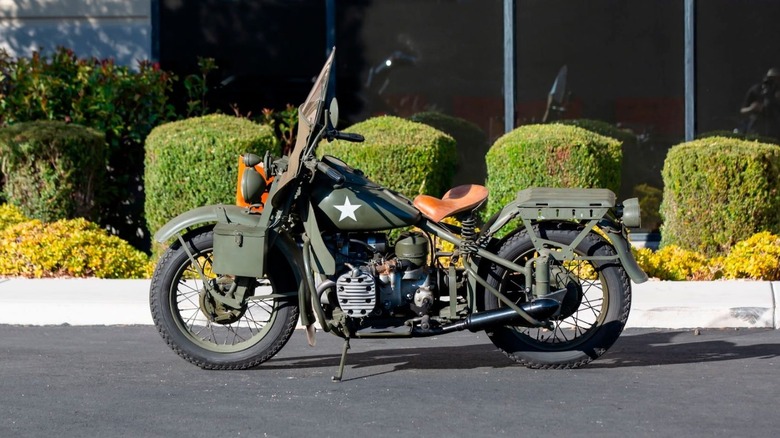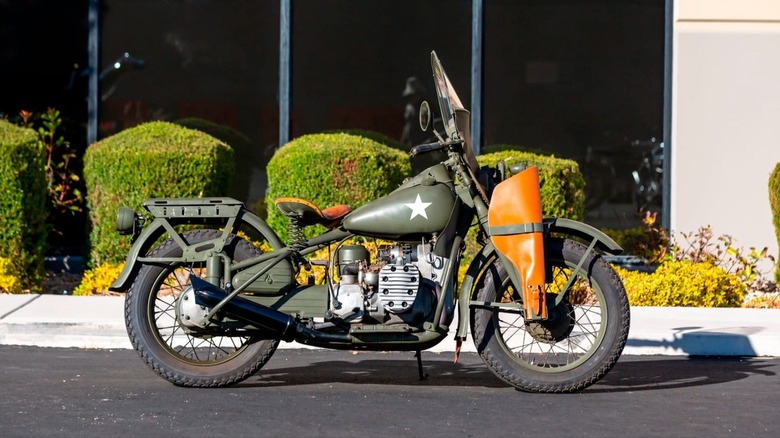The WWII-Era Harley-Davidson That Was Originally Built For The Allied Troops
The mystique of Harley-Davidson runs the gamut from outlaw motorcycle clubs to mid-life crisis 9-to-5 desk jockeys and everything in between. Thanks to Hollywood, the lore of the American motorcycle company has become indelibly branded into our collective psyche. From a certain point of view, it can best be described as the modern-day equivalent of an old west cowboy's horse. Harley-Davidson even served its country bravely on the battlefields around the world.
In 1901 William Harley drew up the first plans for a small engine that could neatly fit on a standard bicycle frame. Brothers Arthur and Walter Davidson joined Harley shortly after, and the first "motor-bicycle" hit the streets in 1903. The rest, as they say, is history. Harley, along with its rival Indian — which prides itself on actually being "America's First Motorcycle Company" — were the only two bike makers to survive the Great Depression.
Fast forward to 1940, and Harley-Davidson began supplying the military with modified versions of its WL street bikes. The "W" indicated the standard 45 cubic inch V-twin engine, and the "L" stood for high compression. It slapped an "A" on the military models, which stood for Army, and became the WLA. The WLA was a respected bike, with nearly 90,000 made during its production run, but it had its flaws.
Harley-Davidson goes to the desert
While the WLA was a capable bike in the European theaters, the same couldn't be said for its use in the desert regions of North Africa, where the U.S. was fighting the Desert Fox, General Erwin Rommel, and his forces.
The V-twin engine of the WLA was overheating (as was the Indian 741), and the military needed a bike that would keep its cool. They also needed something that wouldn't keep getting gummed up by the desert sand, so they tasked Harley and Indian to come up with a solution.
Harley-Davidson came up with the XA (Experimental Army), a design based on BMW's R71, which Rommel's Afrika Korps troops had been using with great success. The XA was an opposed-cylinder motorcycle with the cylinders stuck side by side instead of the usual slipstream inline design. The air-cooled design would keep the engine cool by placing them out in the wind. It did precisely that and plummeted oil temperatures by almost 100 degrees over the WLA models.
The 750cc, 23 horsepower engine had low compression and a top speed of only 65mph (via Hemmings), but it had high torque. They removed the chain and sprocket, notorious for getting torn up by sand, and replaced it with a shaft drive. The XA was equipped with a four-speed, but interestingly enough, this was Harley's very first-hand clutch and foot shift motorcycle. The company wouldn't use this setup again for ten years with the 1952 Panhead (via Wheels Through Time).
The XA came with a lot of firsts
Only about 1,000 XAs were built during one year of production and were made specifically for use in World War II. Almost every part of the bike is specific to the XA, including the frame and a special gas tank. The motorcycle had several additional firsts for Harley, including the plunger-style rear suspension, which it didn't make available on its bigger motorcycles until 1957. It was offered on its smaller K models in 1952.
The bike had a 7-inch ground clearance and a special telescopic fork (via Mecum) two inches longer than standard, which gave it even more clearance. Some models had an additional Monroe shock strapped to the outside to give it more cushion (via Wheels Through Time).
While Harley's traditionally had the kickstart on the right side, the XA had a unique sidekick step starter on the left side. Each cylinder had its own carburetor, another first for Harley. According to Wheels Through Time, Harley only produced 60 XAs with disc wheels instead of spoke wheels (via Wheels Through Time).
You would think that a bike with so many innovative features would traditionally be a no-brainer, but by the time Harley was done testing and building the XA, the general-purpose Jeep had come online and was all the rage. It could carry more passengers and payload than a motorcycle, was easier to drive than its two-wheeled compatriot, and could withstand the rigors of the battlefield better (via Hemmings). In the end, the Experimental Army bike was canceled and faded into the annals of military history.

